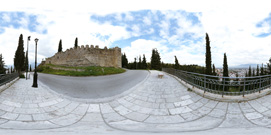Castle of Lamia
The Castle of Lamia stands on the top of a rocky hill while it dominates and controls the Sperchios Valley up to Maliakos Bay as well as the passageway that leads to Thessaly through Orthris. The centre of its main plateau is occupied by the Othonian barrack where the Archaeological Museum of Lamia is hosted. Recent excavation within the walls of the acropolis have shown that the place was inhabited since the Bronze Age (2800-1100 B.C.) and more particular during the Mycenaean Era. The acropolis was the centre of the defense system of Lamia during the Classical/Hellenistic Era and was connected to the walls of the city below. The ancient wall is still preserved in its whole in a very good condition due to its constant use and the continuous repair works. The preserved surrounding wall has a triangular ground plan and a 600-metre perimeter while its height varies reaching 13 metres in its Northwest corner. The thickness of the walls is 1.35m on average and comes to crenellations. The castle has two Gates, one on the Southeast called 'iron gate' through which it was connected to the lower part of the city and one on the Northeast that led to Orthris Mountain. Corroborative towers are near the gates, in the corners of the wall and in every weak defensive spots. Inside the space is divided into two transverse walls into three parts. The north part (donjon) is higher and was used as the ultimate shelter of those fighting for the Castle. The most ancient part of the surroundings was built according to the polygonic system and dates back to the end of the 5th till the beginning of the 4th century B.C. when Lamia became the capital of the state of Malieon and significantly prospered from 413 B.C. At the base of the North West tower we see an equally built trapezoidal construction system that can be dated be to the end of the 5th up to the beginning of the 4th century B.C. Equally constructed rectangle system can be found in many more spots in the base of the wall. It is still dubious is there has been any kind of restoration of the wall in the Justinian Era, The parts of the mortared marble with an intermediate use of synthetic mortar and tiles are probably part of repairs in the byzantine Years as well as of the Franks and the Catalans. The plateau of the Southwest corner was used in the Middle Ages as a bastion and had a reservoir. New amendments and repairs were made during the Turkish Occupation.
The city of Lamia after the mid of the 4th century was conquered by Philip II. In 302 BC it was liberated by Dimitrios the Besieger when it remained under the influence of the Thessalians and the Aitolis until it was occupied by the Romans. During the War of Lamia (323/22 BC) Leosthenis who was the General of the Athenians was killed in front of Lamia’s walls while he was besieging the Macedonians who were defending Lamia. In 190AD Manios Akilios Glabrion occupied and severely plundered the city. In the 13th and 14 century it fell in the hands of the foreign conquerors of the Middle Ages, the Franks and the Catalans and was named ‘the Castle’. In 1446 it was finally occupied by the Turks until the liberation of the city in 1833. In the Othonian Era the central plateau was built as a barrack to meet the needs of the frontier forces. From 1884 till World War II the Castle had been used as a barrack. In 1973 the place was given from the Ministry of Defenmce to the Ministry for Culture and in 1984 the Municipality of Lamia has undertaken its recreation and repair of the barrack in order to house the Archaeological Museum of the city.
It is located in Melina Merkouri street eastwards.







